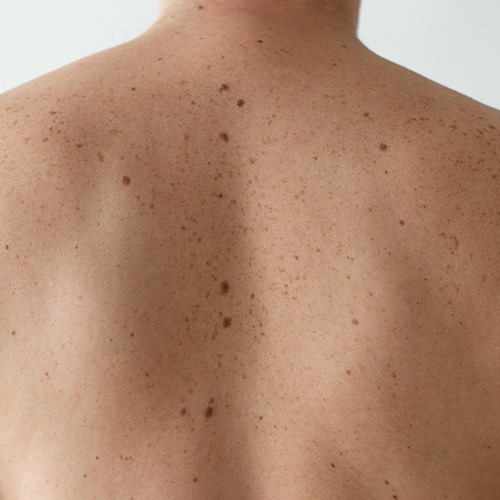Moles are extremely common, normal skin growths that can be found anywhere on the body. There are many different types of moles and they can vary in color, shape, and size. While most moles are harmless, it is important to complete regular at-home skin examinations to monitor any rapid changes and inform a healthcare provider.
Moles (nevi) are flat or raised clusters of skin cells that are generally brown in colour. Moles are the result of sun exposure, genetics, age, and hormonal changes such as pregnancy or puberty. Moles are present in 1% of newborns and by adulthood, most people will have between 10 and 40 moles on their body.

+ Monthly or quarterly at home skin examinations
+ Annual examinations with a dermatologist or family doctor
+ Excision
Not all moles are the same, and while most moles are benign, if you have an atypical mole, it may increase your risk of skin cancer. Atypical moles are larger than a 1/4 inch (end of a pencil eraser), consist of more than 2 colours/very dark in colour, or have an uneven shape. It is important to visit a dermatologist if you believe you have an atypical mole, or are unsure to rule out skin cancer.
It is important to do regular at-home skin examinations monthly or quarterly to assess for rapidly changing qualities in any moles. To do so, stand in a well-lit room, in front of a full length mirror and use a handheld mirror to view hard to reach areas. Start scanning your body from top to bottom, and don’t forget to check your scalp, armpits, and in between your fingers and toes.
Remember the ABDCE’s of melanoma – asymmetry, border irregularity, colour, diameter, and evolution. Ask yourself regarding your spots: Is it a uniform, symmetric shape, are the boarders defined, is it changing colour/getting darker/more than 2 colours, is it larger than a 1/4 inch, and how fast is it changing? It’s also important to note if you have a spot that is persistently painful, itchy, bleeding, or scabbing.
Go to a dermatologist near you, he/she will take a better look at the mole with an instrument called a dermatoscope, which brightens and magnifies to see deeper into the skin. If there is any cause for concern, a very small biopsy may be taken to rule out any malignancy of the mole.
Although moles can be genetic, with many developing in childhood/adolescence, it is possible to prevent new or changing spots by protecting your skin from sun damage. Cover sun-exposed skin with clothing, such as long-sleeved shirts, wide-brimmed hats, and sunglasses. Apply a broad-spectrum (protects against both UVA and UVB rays) sunscreen with an SPF of at least 30 every day, all year round and re-apply every 2 hours. Avoid prolonged exposure to the sun, especially during peak UV index hours between 10 am and 4 pm.
Yes! For non-threatening moles, a referral is not required and cosmetic excision may be considered.
November 24 – December 1st
Save up to 25% OFF SKIN gift cards and use them on your favourites all year long.